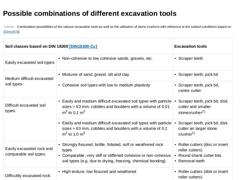
|

|
(Table: Combination possibilities of the various excavation tools as well as the utilization of stone crushers with reference to the subsoil conditions) |
|
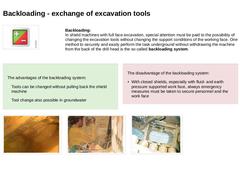
|
Backloading:
In shield machines with full face excavation, special attention must be paid to the possibility of changing the excavation tools without changing the support conditions of the working face. One method to securely and easily perform the task underground without withdrawing the machine from the back of the drill head is the so-called backloading system. The advantages of the backloading system: |
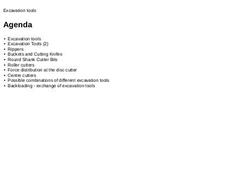
|

|
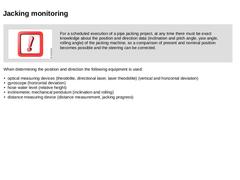
|
|
(Image: Attention!)
For a scheduled execution of a pipe jacking project, at any time there must be exact knowledge about the position and direction data (inclination and pitch angle, yaw angle, rolling angle) of the jacking machine, so a comparison of present and nominal position becomes possible and the steering can be corrected. |
|
When determining the position and direction the following equipment is used: -
optical measuring devices (theodolite, …
|
|
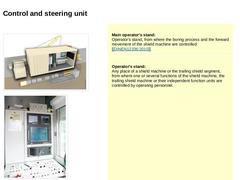
|
|
(Image: Technical components in pipe jacking - control and steering unit) (Image: Control and steering unit) |
Main operator's stand:
Operator's stand, from where the boring process and the forward movement of the shield machine are controlled [ [DINEN12336:2010]]. |
|
Operator's stand:
Any place of a shield machine or the trailing shield segment, from where one or several functions of the shield machine, the trailing shield machine or their independent … |
|
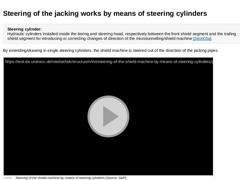
|
Steering cylinder:
Hydraulic cylinders installed inside the boring and steering head, respectively between the front shield segment and the trailing shield segment for introducing or correcting changes of direction of the microtunnelling/shield machine (not found). By extending/drawing in single steering cylinders, the shield machine is steered out of the direction of the jacking pipes. (Video: Steering of the shield machine by means of steering cylinders) |

|

|
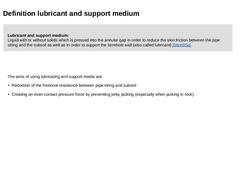
|
Lubricant and support medium:
Liquid with or without solids which is pressed into the annular gap in order to reduce the skin friction between the pipe string and the subsoil as well as in order to support the borehole wall (also called lubricant) [Stein05a]. |
The aims of using lubricating and support media are: |
|
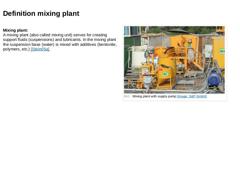
|

Mixing plant:
A mixing plant (also called mixing unit) serves for creating support fluids (suspensions) and lubricants. In the mixing plant the suspension base (water) is mixed with additives (bentonite, polymers, etc.) [Stein05a]. (Image: Mixing plant with supply pump) |
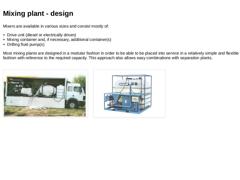
|

Mixers are available in various sizes and consist mostly of: -
Drive unit (diesel or electrically driven)
-
Mixing container and, if necessary, additional container(s)
-
Drilling fluid pump(s)
Most mixing plants are designed in a modular fashion in order to be able to be placed into service in a relatively simple and flexible fashion with reference to the required capacity. This approach also allows easy combinations with separation plants. (Image: Model … |
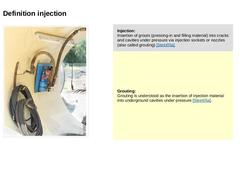
|
|
(Image: Lubrication station) |
Injection:
Insertion of grouts (pressing-in and filling material) into cracks and cavities under pressure via injection sockets or nozzles (also called grouting) [Stein05a]. |
|
Grouting:
Grouting is understood as the insertion of injection material into underground cavities under pressure [Stein05a]. |
|
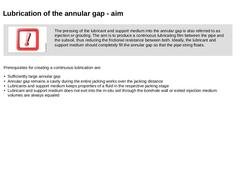
|
|
(Image: Attention!)
The pressing of the lubricant and support medium into the annular gap is also referred to as injection or grouting. The aim is to produce a continuous lubricating film between the pipe and the subsoil, thus reducing the frictional resistance between both. Ideally, the lubricant and support medium should completely fill the annular gap so that the pipe string floats. |
Prerequisites for creating a continuous lubrication are: |
|
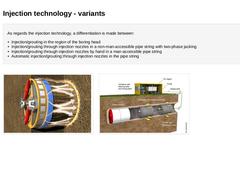
|
As regards the injection technology, a differentiation is made between: -
Injection/grouting in the region of the boring head
-
Injection/grouting through injection nozzles in a non-man-accessible pipe string with two-phase jacking
-
Injection/grouting through injection nozzles by hand in a man-accessible pipe string
-
Automatic injection/grouting through injection nozzles in the pipe string
(Image: Lubricating the pipe string in the ULTIMATE METHOD (… |
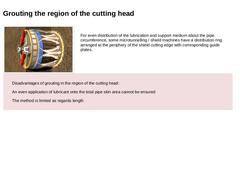
|
|
(Image: Lubricating the pipe string in the ULTIMATE METHOD (Bild 9.5.2) with reference to [FI-Kidoh] [Image: S&P GmbH] - Grouting the lubricating and support medium in the boring head region by means of a special distribution ring) For even distribution of the lubrication and support medium about the pipe circumference, some microtunnelling / shield machines have a distribution ring arranged at the periphery of the shield cutting edge with corresponding … |
|
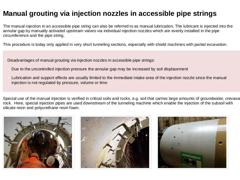
|

The manual injection in an accessible pipe string can also be referred to as manual lubrication. The lubricant is injected into the annular gap by manually activated upstream valves via individual injection nozzles which are evenly installed in the pipe circumference and the pipe string. This procedure is today only applied in very short tunneling sections, especially with shield machines with partial excavation. Disadvantages of manual grouting via … |
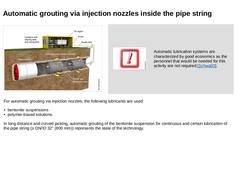
|
|
(Image: T.B.K. system for lubricating the jacking string with reference to [FI-TBKa] [Image: S&P GmbH]) |
(Image: Attention!)
Automatic lubrication systems are characterized by good economics as the personnel that would be needed for this activity are not required [Schwa00]. |
|
For automatic grouting via injection nozzles, the following lubricants are used: -
bentonite suspensions
-
polymer-based solutions.
In long distance and curved jacking, automatic … |
|
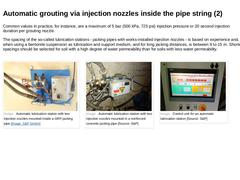
|
Common values in practice, for instance, are a maximum of 5 bar (500 kPa, 725 psi) injection pressure or 20 second injection duration per grouting nozzle. The spacing of the so-called lubrication stations - jacking pipes with works-installed injection nozzles - is based on experience and, when using a bentonite suspension as lubrication and support medium, and for long jacking distances, is between 9 to 15 m. Example: Every third jacking pipe (3 m) … |
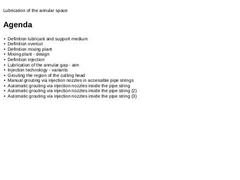
|

|
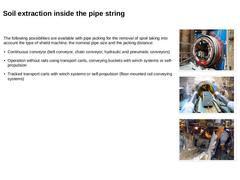
|
The following possibilities are available with pipe jacking for the removal of spoil taking into account the type of shield machine, the nominal pipe size and the jacking distance: -
Continuous conveyor (belt conveyor, chain conveyor, hydraulic and pneumatic conveyors)
-
Operation without rails using transport carts, conveying buckets with winch systems or self-propulsion
-
Tracked transport carts with winch systems or self-propulsion (floor-mounted …
|
|
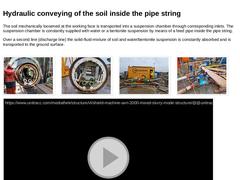
|
The soil mechanically loosened at the working face is transported into a suspension chamber through corresponding inlets. The suspension chamber is constantly supplied with water or a bentonite suspension by means of a feed pipe inside the pipe string. Over a second line (discharge line) the solid-fluid-mixture of soil and water/bentonite suspension is constantly absorbed and is transported to the ground surface. (Image: Hydraulic soil conveying) (… |
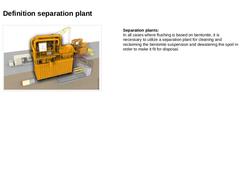
|
(Image: Technical components in pipe jacking - separation plant) Separation plants:
In all cases where flushing is based on bentonite, it is necessary to utilize a separation plant for cleaning and reclaiming the bentonite suspension and dewatering the spoil in order to make it fit for disposal. |
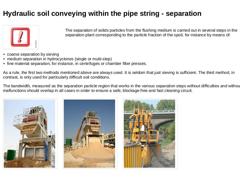
|

The separation of solids particles from the flushing medium is carried out in several steps in the separation plant corresponding to the particle fraction of the spoil, for instance by means of: -
coarse separation by sieving
-
medium separation in hydrocyclones (single or multi-step)
-
fine material separation, for instance, in centrifuges or chamber filter presses.
As a rule, the first two methods mentioned above are always used. … |
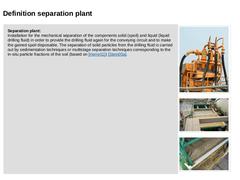
|
|
Separation plant:
Installation for the mechanical separation of the components solid (spoil) and liquid (liquid drilling fluid) in order to provide the drilling fluid again for the conveying circuit and to make the gained spoil disposable. The separation of solid particles from the drilling fluid is carried out by sedimentation techniques or multistage separation techniques corresponding to the in-situ particle fractions of the soil (based on [… |
|
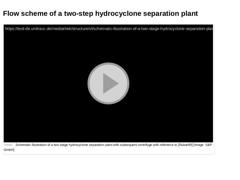
|
(Video: Schematic illustration of a two-stage hydrocyclone separation plant with subsequent centrifuge) |
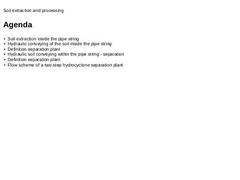
|

|